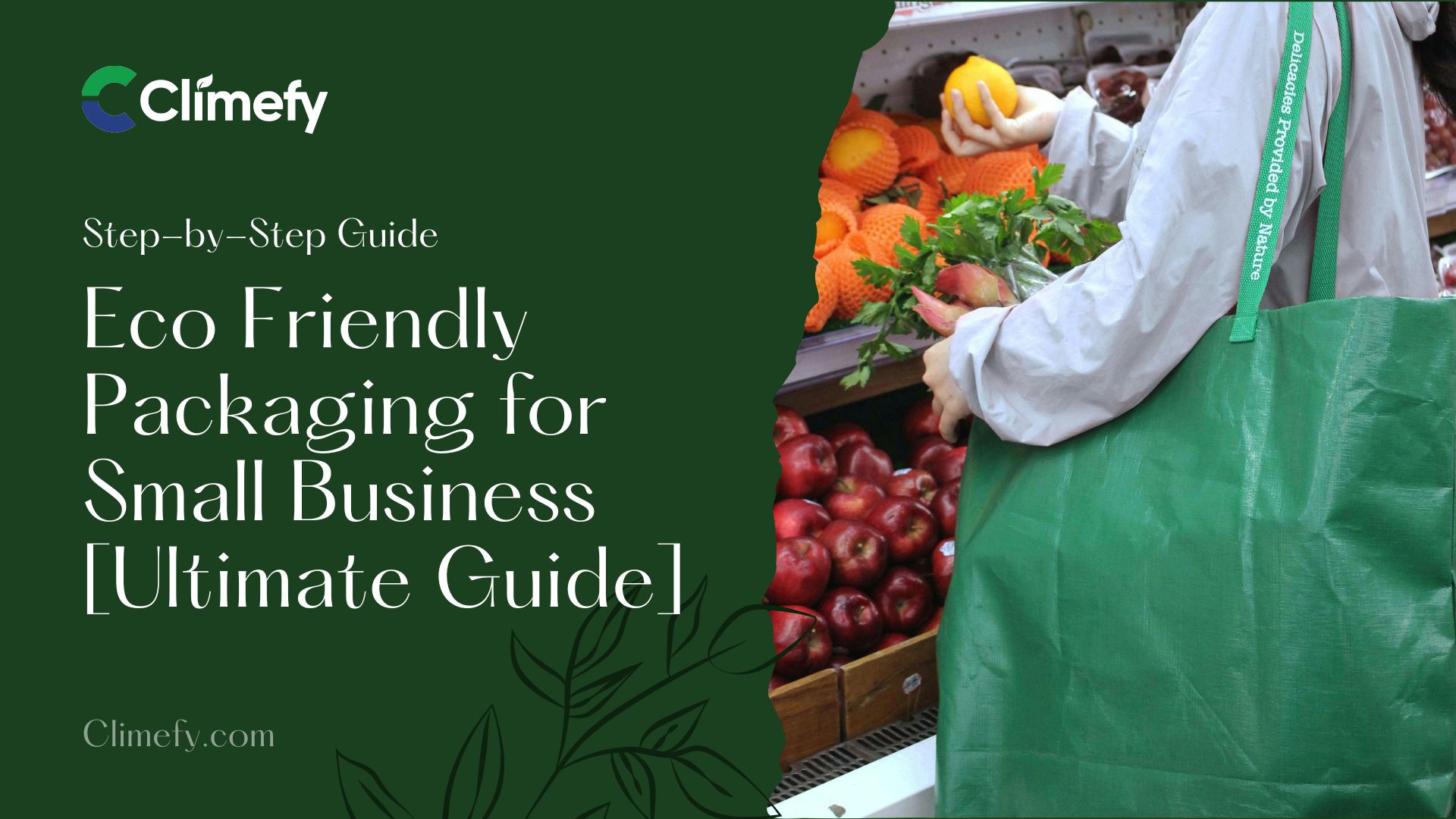

Eco-friendly packaging for small businesses is no longer a niche trend but a fundamental component of modern, responsible commerce. It represents a strategic shift towards materials and processes that minimize environmental impact, from sourcing to end-of-life, while simultaneously building brand value and meeting consumer demand. This comprehensive guide will demystify sustainable packaging, providing a clear, actionable roadmap for small business owners to make this critical transition successfully, reducing their carbon footprint and enhancing their market appeal.
In this ultimate guide, you will learn:
Read More:
![Eco Friendly Packaging for Small Business [Ultimate Guide] 1 Eco-Friendly-Packaging-for-Small-Business](https://climefy.com/wp-content/uploads/2025/10/Eco-Friendly-Packaging-for-Small-Business-1024x576.jpg)
Eco-friendly packaging, often used interchangeably with terms like sustainable packaging, green packaging, and environmentally conscious packaging, refers to the development and use of packaging solutions that have a reduced environmental impact and footprint throughout their life cycle. This encompasses the sourcing of raw materials, manufacturing, transport, usage, and end-of-life disposal or reuse.
The core principle is a circular economy model, which aims to eliminate waste and the continual use of resources, moving away from the traditional linear “take-make-dispose” model. For a small business, adopting sustainable packaging is not just an ethical choice; it’s a powerful strategic decision.
It directly addresses growing consumer demand for corporate responsibility, can lead to significant cost savings through material efficiency, future-proofs the business against tightening environmental regulations, and builds an authentic, trustworthy brand image that resonates with a modern audience. Utilizing a tool like the Climefy carbon calculator for small & medium companies can help you quantify the positive impact of this shift.
Key characteristics of truly eco-friendly packaging include:
✔ Renewable Resources: Materials derived from rapidly replenishing sources, such as bamboo, cornstarch, or mushroom mycelium.
✔ Biodegradability and Compostability: The ability of the material to break down naturally into non-toxic components, returning to the earth.
✔ Recycled Content: Using materials that have been reprocessed from recovered waste, reducing the need for virgin materials.
✔ Reusability and Recyclability: Designing packaging for multiple lifecycles or easy integration into existing recycling streams.
✔ Non-Toxicity: Ensuring the packaging is free from harmful chemicals and pollutants.
✔ Resource Efficiency: Minimizing material usage, weight, and volume through smart design (a concept known as “lightweighting”).
The landscape of sustainable packaging materials is diverse and innovative, offering solutions for virtually every product type. Understanding the nuances of each material is crucial for making an informed decision that aligns with your product needs, brand values, and budget. These materials can be broadly categorized into several groups, each with unique properties, benefits, and considerations for end-of-life management.
Plant-based packaging is derived from agricultural crops or by-products, offering a renewable alternative to petroleum-based plastics. These materials are often designed to be compostable, meaning they will break down in an industrial composting facility into nutrient-rich compost.
✔ Cornstarch Packaging: Made from polylactic acid (PLA), a bioplastic derived from corn. It is compostable under specific industrial conditions but should not be confused with home-compostable materials.
✔ Mushroom Packaging: Grown from mycelium (the root structure of mushrooms) and agricultural waste into custom shapes. It is fully home-compostable and biodegradable.
✔ Seaweed and Algae Packaging: An emerging, highly renewable material that requires no freshwater or fertilizer to grow. It is edible and fully biodegradable.
✔ Bagasse Packaging: Made from the fibrous residue left after crushing sugarcane, bagasse is sturdy, microwave-safe, and compostable. It’s an excellent replacement for polystyrene foam clamshells and plates.
✔ Palm Leaf Packaging: Made from the fallen leaves of the Areca palm tree, this material is naturally molded into plates and bowls without any chemicals or binders. It is biodegradable and compostable.
This category focuses on closing the loop by using post-consumer or post-industrial waste to create new packaging, reducing the demand for virgin materials and diverting waste from landfills.
✔ Recycled Cardboard and Paper: The cornerstone of sustainable packaging, these materials have well-established recycling streams. Look for products with high Post-Consumer Recycled (PCR) content.
✔ Recycled PET (rPET): Made from recycled plastic bottles, rPET is a widely used material for clamshells, bottles, and bags. It significantly reduces energy consumption compared to virgin PET.
✔ Glass and Aluminum: Infinitely recyclable without loss of quality. These materials are heavy and energy-intensive to produce initially, but their recyclability makes them a strong long-term option.
✔ Post-Consumer Recycled (PCR) Plastics: This refers to any plastic material that has been recycled from consumer waste, not just PET. Using PCR plastics supports the market for recycled materials.
This approach rethinks the very purpose of packaging, moving from a single-use item to a durable asset within a circular system.
✔ Returnable and Refillable Containers: A model where customers return packaging for cleaning and reuse. This is common in niche markets and is gaining traction through modern delivery services.
✔ Upcycled Materials: Packaging created from waste materials that are transformed into products of higher quality or value, such as fabric pouches made from textile off-cuts.
✔ Edible Packaging: An innovative, zero-waste solution where the packaging itself can be consumed, often made from materials like seaweed, rice paper, or beeswax.
Transitioning to sustainable packaging requires a systematic approach to ensure the new solution is practical, cost-effective, and aligned with your brand. Rushing the process can lead to poor choices that create more problems than they solve.
This step-by-step guide will help you navigate the change methodically, from initial audit to successful implementation and communication. Partnering with an expert like Climefy for can provide tailored guidance throughout this journey.
Begin by thoroughly analyzing your current packaging ecosystem. You cannot improve what you do not measure.
With a clear understanding of your current state, establish what you want to achieve. Your goals will shape your search for alternatives.
This is the hands-on phase of finding your new packaging. Don’t skip the sampling stage.
Sustainable packaging can sometimes have a higher upfront cost, but a holistic view often reveals savings elsewhere.
Before a full-scale rollout, conduct a controlled pilot test with a segment of your customer base.
Once you are confident in your new solution, implement it fully and tell your story loudly and proudly.
The perception that eco-friendly packaging is prohibitively expensive is one of the biggest barriers for small businesses. However, a nuanced analysis reveals a more complex and often favorable picture. The cost must be evaluated not just as a line item for materials, but through a wider lens that includes operational efficiencies, brand equity, and environmental impact. To fully understand the environmental cost savings, businesses can use the Climefy carbon calculator for small & medium companies to measure their emission reductions.
While the per-unit cost of certain sustainable materials can be higher, this is only one part of the financial equation.
The “cost” of packaging extends far beyond its price tag. Conventional packaging has significant hidden environmental costs, often referred to as externalities.
The market is filled with environmental claims, making it essential for businesses to look for independent, third-party certifications to avoid “greenwashing.”
✔ Forest Stewardship Council (FSC): Certifies that paper and wood products come from responsibly managed forests.
✔ Biodegradable Products Institute (BPI): Certifies that products and packaging are compostable in commercial composting facilities.
✔ How2Compost: A clear labeling system that instructs consumers on how to compost the packaging.
✔ Cradle to Cradle Certified: A rigorous standard assessing a product’s safety, circularity, and responsibility across its entire life cycle.
✔ The Climefy Verified Carbon Standard (CVCS): For businesses looking to ensure their entire packaging lifecycle is carbon-neutral, the Climefy Verified Carbon Standard provides a framework for verifying the carbon reductions, which can then be offset through high-quality projects.
Adopting eco-friendly packaging is a significant achievement, but its full value is only realized when it is effectively communicated to your customers. Transparency and education are key to turning your sustainability efforts into a powerful brand asset that builds loyalty and trust. Avoid vague terms like “earth-friendly” and instead use clear, specific language and calls to action.
The unboxing experience is your prime opportunity to communicate your commitment directly.
Your digital platforms are ideal for telling the deeper story behind your packaging choices.
Consumers are increasingly savvy and skeptical of hollow environmental claims. Authenticity is paramount.
The journey towards comprehensive sustainability extends beyond just packaging. It involves understanding and managing your entire carbon footprint. This is where a holistic partner like Climefy becomes invaluable, offering the tools, expertise, and infrastructure to transform your sustainability ambitions into verified, credible action. Climefy’s suite of services is designed to support small businesses at every stage of their environmental journey, making complex processes accessible and manageable.
The first step to managing your impact is to measure it. Climefy provides tailored calculators that make this process straightforward.
Even after implementing the most sustainable packaging and operational efficiencies, some carbon emissions may be unavoidable. Carbon offsetting is a credible way to take responsibility for this residual footprint.
Navigating the world of sustainability can be complex. Continuous education is key to making informed decisions.
For businesses looking to offer sustainability at the point of sale, Climefy’s Digital Integration Solutions provide the technology to make it happen.
The most cost-effective entry point is often recycled cardboard and paper. These materials have a mature market, are widely available, and are generally less expensive than innovative bioplastics or reusable systems. Start by simply switching your shipping boxes and void fill (e.g., from plastic bubble wrap to crumpled kraft paper or recycled cardboard shreds) to see an immediate improvement without a significant cost increase.
It’s a complex topic. Most “biodegradable” plastics, like PLA, only break down in specific conditions found in industrial composting facilities, not in home composts or landfills. If your customer base does not have access to such facilities, these plastics can contaminate recycling streams and offer little environmental benefit. It’s often better to choose materials with clear and accessible end-of-life options, like paper or cardboard, that can be easily recycled at home.
The key is rigorous testing. Always request samples from your supplier and conduct drop tests, vibration tests, and simulate shipping conditions. The sustainable aspect of the packaging should not compromise its primary function: product protection. Many sustainable materials, like molded pulp or corrugated cardboard, offer excellent strength and cushioning.
While not every customer prioritizes sustainability, a significant and growing demographic does. Furthermore, environmental regulations are tightening globally. Proactively adopting sustainable practices future-proofs your business against potential fees or bans on certain single-use plastics. It also enhances your brand reputation, can reduce long-term costs, and attracts top talent who want to work for responsible companies.
Consider a phased approach. Start by changing one component at a time. Communicate the change to your customers and see if you can incorporate a slight price increase to cover the cost—many are willing to pay a premium. Also, analyze the total cost of ownership; the savings from reduced shipping costs due to lighter packaging can often offset the higher material cost over time.